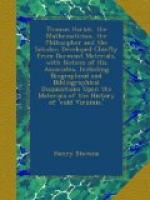Think of me as your sincere friend. Your interests are involved as well as mine. My recovery will be your triumph, but through the Almighty who is the Author of all good things. As I have now and then said, I believe these three points. I believe in God Almighty; I believe that Medicine was ordained by him ; I trust the Physician as his minister. My faith is sure, my hope firm. I wait however with patience for everything in its own time according to His Providence. We must act earnestly, fight boldly, but in His name, and we shall conquer. Sic transit gloria mundi, omnia transibunt, nos ibimus, ibitis, ibunt. So passes away the glory of this world, all things shall pass away, we shall pass away, you will pass away, they will pass away.
There is unfortunately no portrait known of Hariot, and we can form no idea of his personal appearance; but, fortunately, the drafts of the three Latin letters to his eminent friend at Court, alluded to above, fully describe his terrible disease and other bodily infirmities in 1615 and 1616, and give us some notion of himself and his personal habits. His regular physician was Dr Turner, and his apothecary Mr May-orne, both employed also by Sir Walter.
Dr Alexander Read, in his ’ Chirurgicall Lectures of Tumors and Vlcers Delivered in the Chirurgeans Hall, 1632-34. London. 1638,’ 4°, says in Treatise 2, Lecture 26, page 307:
Cancerous ulcers also feize upon this part [lips]. This grief haftened the end of that famous Mathematician, Mr. Hariot, with whom I was acquainted but a fhorttime before his death : whom at one time, together with Mr. Hughes, who wrote of the Globes, Mr. Warner, and Mr. Torperley, the Noble Earl of Northumberland, the favourer of all good learning, and Mecænas of learned men, maintained while he was in the Tower for their worth and various literature
A great deal of misconception has hitherto prevailed respecting Hariot’s great printed work on Algebra. His reputation as a mathematician has been permitted to hinge chiefly upon it, very much to his disadvantage. A brief bibliographical statement of facts will probably present the matter in a new light. But first let the book be described as it lies before us and has been described by many others since the days of Professor Wallis, nearly two hundred years ago. The Title is as follows : ’Artis Analyticæ / Praxis / Ad æquationes Algebraicas nouæ, expeditæ, & generali / methodo, resoluendas : / Tractatus/ E posthumis THOMÆ HARRIOTI Philosophi ac Mathematici ce- / leberrimi sche-diasmatis summæ fide & diligentia / descriptus:/ Et/Illvstrissimo Domino/Dom. HenricoPercio,/ Northvmbriæ Comiti,/Qui hæc primò, sub Patronatus & Munificentiæ suæ auspicjss / ad proprios vsus elucubrata, in communem Mathematicorum / vtilitatem, denuò reuisenda, describenda, & publicanda / mandauit, meritissimi Honoris ergò / Nuncupatus. / Londini / Apud Robertvm Barker, Typographum / Regium : Et Hæred. Io. Billii. Anno 1631. Title, reverse blank; Prefatio 4 pages; Text 180 pages, and Errata 1 page (Bbb) followed by a blank page, folio. A very handsomely printed book. In the British Museum, 529 m 8, is Charles the First’s copy in old calf, gilt edges, with the royal arms on the sides. In the Preface the editors (Aylesbury and Prothero aided by Warner)say:




